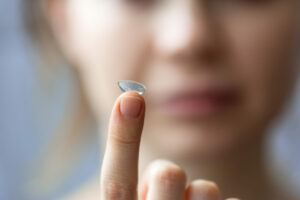March 1, 2023
By Ornella Koumbo, PhD, Brien Holden Vision Institute

Optical interventions that introduce myopic defocus at the peripheral retina have been utilized to slow eye growth and, thus, to slow myopia progression. Hyperopia is said to occur from insufficient eye growth resulting in an eye that is too short for its refractive power. Thus, it is of interest to determine if eye growth in hyperopic eyes can be accelerated with optical devices that impose relative peripheral hyperopic defocus.
This prospective study investigated whether axial growth and refractive error can be modulated in hyperopic children by imposing relative peripheral hyperopic defocus using multifocal soft contact lenses. A total of 22 young hyperopes were allocated to one of two non-randomized natural progression and hyperopic intervention groups and followed over a three-year period. In the intervention group, the participants were observed for the first six months without any intervention. Then, a center near multifocal soft contact lens was used bilaterally from six to 30 months. For the final six months, the intervention was withdrawn. A soft center-near multifocal contact lens with an add power of +2.00D was used. The central “near” portion of the contact lens corrected distance refractive error, while the “distance” portion imposed hyperopic defocus. Axial length and refractive error measurements were taken at baseline and every six months.
There was no change in axial length in either group for the first six months. After that, axial length increased in both groups, but it was greater in the intervention group than in the control group. A more myopic shift in refractive error was observed in the test group. For the final six months, there were no significant changes in axial length or refractive error. The results are promising and indicate that there are avenues to accelerate axial length in hyperopes.
Abstract
The Effect of Peripheral Defocus on Axial Growth and Modulation of Refractive Error in Hyperopes
Ian G Beasley, Leon N Davies, Nicola S Logan
Purpose: To establish whether axial growth and refractive error can be modulated in hyperopic children by imposing relative peripheral hyperopic defocus using multifocal soft contact lenses.
Methods: A prospective controlled study with hyperopic participants allocated to a control or test group. Control group participants were corrected with single-vision spectacles, and changes to axial length and refractive error were followed for three years. For the test group, axial growth and post-cycloplegic refractive error were observed with participants wearing single-vision spectacles for the first six months of the trial and then corrected with center-near multifocal soft contact lenses with a 2.00D add for two years. The central “near” portion of the contact lens corrected distance refractive error while the “distance” portion imposed hyperopic defocus. Participants reverted to single-vision spectacles for the final six months of the study.
Results: Twenty-two participants, mean age 11.13 years (SD 1.72) (range 8.33-13.92), completed the trial. Axial length did not change during the first six months in either group (p = 1.00). Axial growth across the two-year intervention period was 0.17 mm (SEM 0.04) (p < 0.0005) in the test group versus 0.06 mm (SEM 0.07) (p = 0.68) in the control group. Axial length was invariant during the final six months in either group (p = 1.00). Refractive error was stable during the first six months in both groups (p = 1.00). Refractive error change across the two-year intervention period was -0.26 D (SEM 0.14) (p = 0.38) in the test group versus -0.01 D (SEM 0.09) (p = 1.00) in the control group. Neither the test (p = 1.00) nor the control (p = 0.63) group demonstrated a change in refractive error during the final six months.
Conclusions: The rate of axial growth can be accelerated in children with hyperopia using center-near multifocal soft contact lenses.
Beasley, I. G., Davies, L. N., & Logan, N. S. (2022). The effect of peripheral defocus on axial growth and modulation of refractive error in hyperopes. Ophthalmic and Physiological Optics, 42(3), 534-544.
DOI: https://doi.org/10.1111/opo.12951
 |
Dr. Ornella Koumbo is a qualified optometrist, currently employed by the Brien Holden Foundation, working within the Haiti Optometry School Project as the Senior Lecturer and Course Coordinator at the Universite d’Etat d’Haiti in Port au Prince, Haiti. Dr. Koumbo is a dedicated educator who is committed to providing the new cohorts of students with the knowledge and skills they need to succeed in the field of optometry and service their local communities. She earned her degree in optometry from the Bausch + Lomb School of Optometry, and she earned her PhD in optometry from the University of New South Wales, supported by BHVI. Dr. Koumbo’s research focuses on myopia control, refractive error correction, and optical equipment. She has a continuing interest in research and has ambitions to continue following similar research topics with greater depth in the future. |













